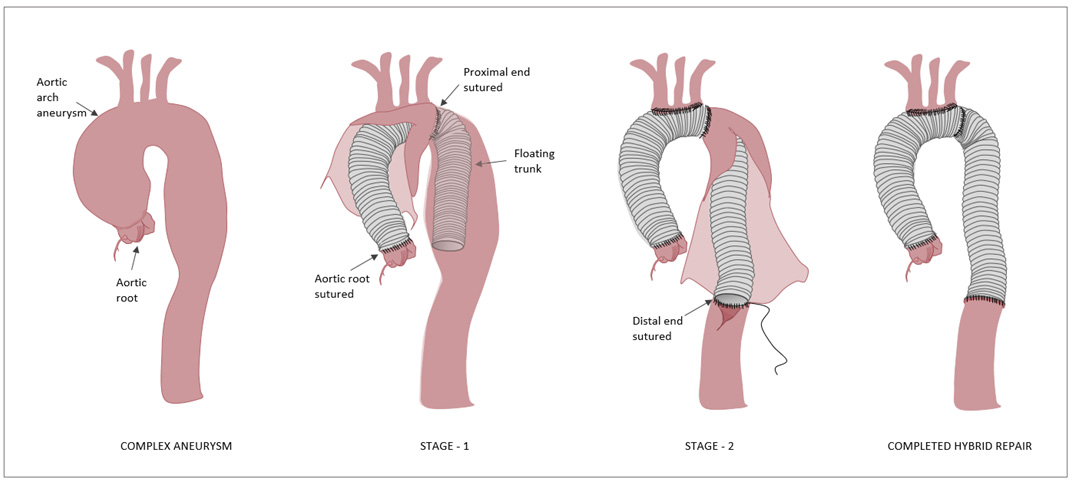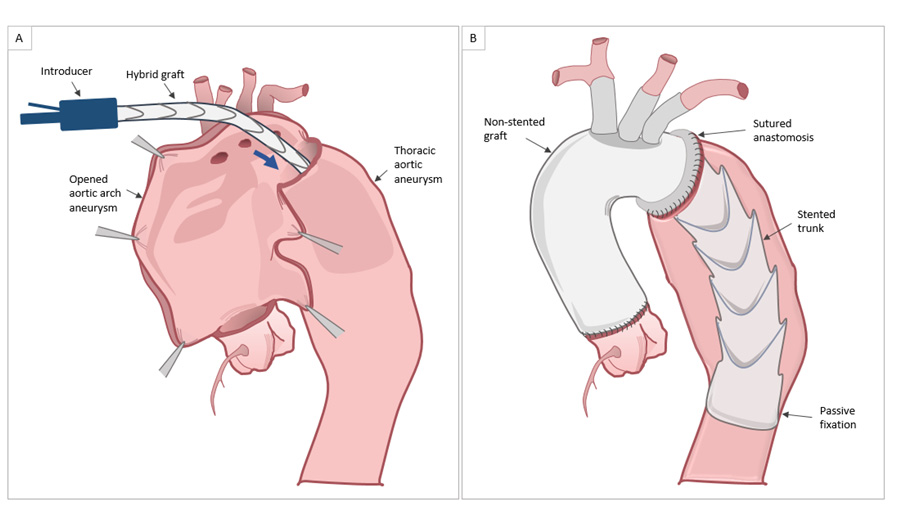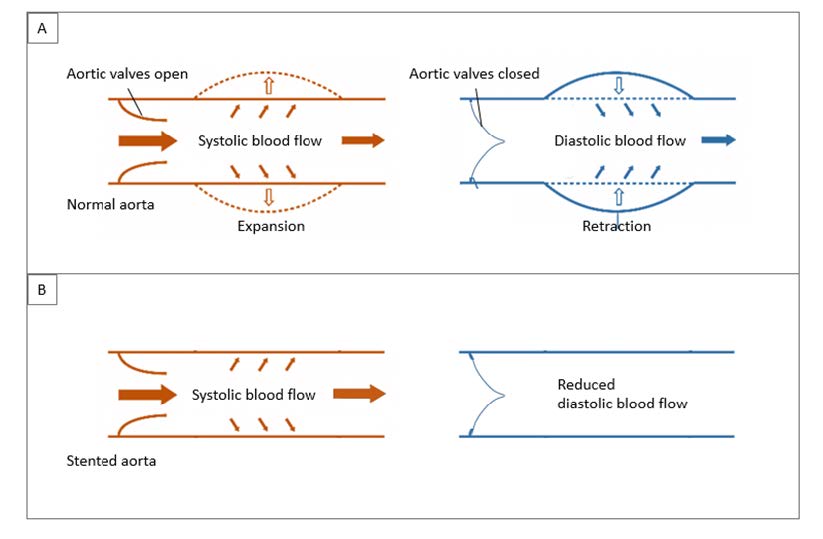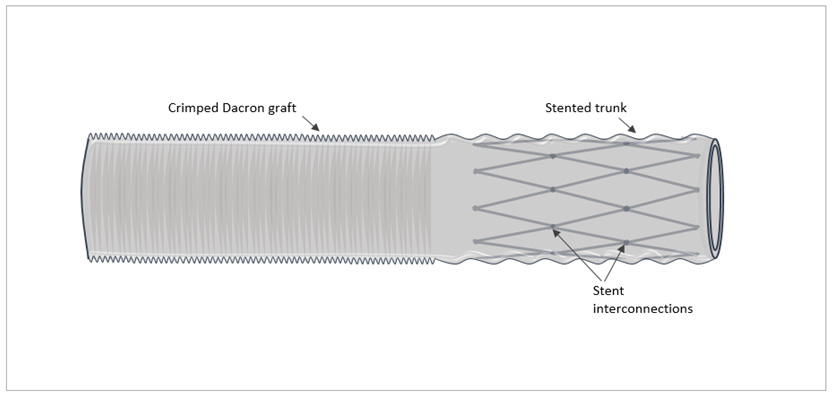|
[1]
|
Powell JT, Brown LC (2001) The natural history of abdominal aortic aneurysms and their risk of rupture. Acta Chir Belg 101: 11-16.
|
|
[2]
|
Go AS, Mozaffarian D, Roger VL, et al. (2013) Heart disease and stroke statistics—2013 update: a report from the American Heart Association. Circulation 127: e6-e245. doi: 10.1161/CIR.0b013e31828124ad

|
|
[3]
|
Kourliouros A, Vecht J, Kakouros N, et al. (2011) Frozen elephant trunk as an effective alternative to open and hybrid two-stage procedures for complex aortic disease. Hellenic J Cardiol 52: 337-344.
|
|
[4]
|
Hynes N, Sultan S (2007) A prospective clinical, economic, and quality-of-life analysis comparing endovascular aneurysm repair (EVAR), open repair, and best medical treatment in high-risk patients with abdominal aortic aneurysms suitable for EVAR: The Irish patient trial. J Endovasc Ther 14: 763-776. doi: 10.1583/07-2194.1

|
|
[5]
|
Schoder M, Lammer J, Czerny M (2009) Endovascular aortic arch repair: hopes and certainties. Eur J Vasc Endovasc Surg 38: 255-261. doi: 10.1016/j.ejvs.2009.06.007

|
|
[6]
|
Karck M, Kamiya H (2008) Progress of the treatment for extended aortic aneurysms; is the frozen elephant trunk technique the next standard in the treatment of complex aortic disease including the arch? Eur J Cardiothorac Surg 33: 1007-1013. doi: 10.1016/j.ejcts.2008.02.030

|
|
[7]
|
Spadaccio C, Nappi F, Al-Attar N, et al. (2016) Old myths, new concerns: the long-term effects of ascending aorta replacement with dacron grafts. Not all that glitters is gold. J Cardiovasc Transl Res 9: 334-342.
|
|
[8]
|
Spadaccio C, Rainer A, Barbato R, et al. (2013) The fate of large-diameter Dacron® vascular grafts in surgical practice: Are we really satisfied? Int J Cardiol 168: 5028-5029. doi: 10.1016/j.ijcard.2013.07.165

|
|
[9]
|
Moore Jr JE (2009) Biomechanical issues in endovascular device design. J Endovasc Ther 16 Suppl 1: 1-11.
|
|
[10]
|
Kiguchi M, Chaer RA (2011) Endovascular repair of thoracic aortic pathology. Expert Rev Med Devices 8: 515-525. doi: 10.1586/erd.11.17

|
|
[11]
|
Ishimaru S (2004) Endografting of the aortic arch. J Endovasc Ther 11: II-62-II-71.
|
|
[12]
|
Akin I, Ince H, Kische S, et al. (2009) Implication of thoracic aortic stent-graft conformability on clinical outcomes. Acta Chir Belg 109: 20-26. doi: 10.1080/00015458.2009.11680366

|
|
[13]
|
Desai ND, Burtch K, Moser W, et al. (2012) Long-term comparison of thoracic endovascular aortic repair (TEVAR) to open surgery for the treatment of thoracic aortic aneurysms. J Thorac Cardiovasc Surg 144: 604-611. doi: 10.1016/j.jtcvs.2012.05.049

|
|
[14]
|
Walsh SR, Tang TY, Sadat U, et al. (2008) Endovascular stenting versus open surgery for thoracic aortic disease: Systematic review and meta-analysis of perioperative results. J Vasc Surg 47: 1094-1098. doi: 10.1016/j.jvs.2007.09.062

|
|
[15]
|
Hinchliffe RJ, Krasznai A, SchultzeKool L, et al. (2007) Observations on the failure of stent-grafts in the aortic arch. Eur J Vasc Endovasc Surg 34: 451-456. doi: 10.1016/j.ejvs.2007.06.005

|
|
[16]
|
Palma JH, Guilhen JS, Gaia DF, et al. (2008) Early complication after hybrid thoracic aortic aneurysm repair. Interact Cardiovasc Thorac Surg 7: 441-443. doi: 10.1510/icvts.2007.168872

|
|
[17]
|
Shimizu H, Ueda T, Enoki C, et al. (2000) Surgical treatment of a distal arch pseudoaneurysm and migrated stent-graft after interrupted aortic arch repair. Ann Thorac Cardiovasc Surg 6: 339-341.
|
|
[18]
|
Yamazaki I, Imoto K, Suzuki S, et al. (2001) Midterm results of stent-graft repair for thoracic aortic aneurysms: Computed tomographic evaluation. Artif Organs 25: 223-227. doi: 10.1046/j.1525-1594.2001.025003223.x

|
|
[19]
|
Borst HG, Walterbusch G, Schaps D (1983) Extensive aortic replacement using "elephant trunk" prosthesis. Thorac Cardiovasc Surg 31: 37-40. doi: 10.1055/s-2007-1020290

|
|
[20]
|
Kato M, Ohnishi K, Kaneko M, et al. (1996) New graft-implanting method for thoracic aortic aneurysm or dissection with a stented graft. Circulation 94: II188-II193.
|
|
[21]
|
Suto Y, Yasuda K, Shiiya N, et al. (1996) Stented elephant trunk procedure for an extensive aneurysm involving distal aortic arch and descending aorta. J Thorac Cardiovasc Surg 112: 1389-1390. doi: 10.1016/S0022-5223(96)70157-5

|
|
[22]
|
Szeto WY, Bavaria JE (2009) Hybrid repair of aortic arch aneurysms: Combined open arch reconstruction and endovascular repair. Semin Thorac Cardiovasc Surg 21: 347-354. doi: 10.1053/j.semtcvs.2009.11.007

|
|
[23]
|
Melissano G, Civilini E, Bertoglio L, et al. (2007) Results of endografting of the aortic arch in different landing zones. Eur J Vasc Endovasc Surg 33: 561-566. doi: 10.1016/j.ejvs.2006.11.019

|
|
[24]
|
Cao P, Verzini F, De Rango P, et al. (2009) Different types of thoracic endografts. J Cardiovasc Surg 50: 483-492.
|
|
[25]
|
Nienaber CA, Kische S, Ince H (2007) Thoracic aortic stent-graft devices: Problems, failure modes, and applicability. Semin Vasc Surg 20: 81-89. doi: 10.1053/j.semvascsurg.2007.04.005

|
|
[26]
|
Fleissner F, Haverich A, Shrestha M, et al. (2015) Stent graft perforation of a frozen elephant prosthesis: does design matter? Interact Cardiovasc Thorac Surg 21: 688-690. doi: 10.1093/icvts/ivv201

|
|
[27]
|
Neequaye S, Abraham C (2013) Total endograft replacement of aortic arch. Ann Cardiothorac Surg 2: 362-366.
|
|
[28]
|
van Prehn J, Vincken KL, Muhs BE, et al. (2007) Toward endografting of the ascending aorta: insight into dynamics using dynamic cine-CTA. J Endovasc Ther 14: 551-560. doi: 10.1177/152660280701400418

|
|
[29]
|
Cheng SWK, Lam ESK, Fung GSK, et al. (2008) A computational fluid dynamic study of stent graft remodeling after endovascular repair of thoracic aortic dissections. J Vasc Surg 48: 303-310. doi: 10.1016/j.jvs.2008.03.050

|
|
[30]
|
Jin S, Oshinski J, Giddens DP (2003) Effects of wall motion and compliance on flow patterns in the ascending aorta. J Biomech Eng 125: 347-354. doi: 10.1115/1.1574332

|
|
[31]
|
Frazin LJ, Lanza G, Vonesh M, et al. (1990) Functional chiral asymmetry in descending thoracic aorta. Circulation 82: 1985-1994. doi: 10.1161/01.CIR.82.6.1985

|
|
[32]
|
Belz GG (1995) Elastic properties and Windkessel function of the human aorta. Cardiovasc Drug Ther 9: 73-83. doi: 10.1007/BF00877747

|
|
[33]
|
Shadwick RE (1999) Mechanical design in arteries. J Exp Biol 202: 3305-3313.
|
|
[34]
|
Mohiaddin RH, Underwood SR, Bogren HG, et al. (1989) Regional aortic compliance studied by magnetic resonance imaging: The effects of age, training, and coronary artery disease. Br Heart J 62: 90-96. doi: 10.1136/hrt.62.2.90

|
|
[35]
|
Saouti N, Marcus JT, Vonk Noordegraaf A, et al. (2012) Aortic function quantified: The heart's essential cushion. J Appl Physiol 113: 1285-1291. doi: 10.1152/japplphysiol.00432.2012

|
|
[36]
|
Tremblay D, Zigras T, Cartier R, et al. (2009) A comparison of mechanical properties of materials used in aortic arch reconstruction. Ann Thorac Surg 88: 1484-1491. doi: 10.1016/j.athoracsur.2009.07.023

|
|
[37]
|
Alderson H, Zamir M (2004) Effects of stent stiffness on local haemodynamics with particular reference to wave reflections. J Biomech 37: 339-348. doi: 10.1016/S0021-9290(03)00289-6

|
|
[38]
|
Ioannou CV, Stergiopulos N, Katsamouris AN, et al. (2003) Hemodynamics induced after acute reduction of proximal thoracic aorta compliance. Eur J Vasc Endovasc Surg 26: 195-204. doi: 10.1053/ejvs.2002.1917

|
|
[39]
|
Kim SY, Hinkamp TJ, Jacobs WR, et al. (1995) Effect of an inelastic aortic synthetic vascular graft on exercise hemodynamics. Ann Thorac Surg 59: 981-989. doi: 10.1016/0003-4975(95)00068-V

|
|
[40]
|
Lantelme P, Dzudie A, Milon H, et al. (2009) Effect of abdominal aortic grafts on aortic stiffness and central hemodynamics. J Hypertens 27: 1268-1276. doi: 10.1097/HJH.0b013e3283299b22

|
|
[41]
|
Morris L, Stefanov F, Hynes N, et al. (2016) An experimental evaluation of device/arterial wall compliance mismatch for four stent-graft devices and a multi-layer flow modulator device for the treatment of abdominal aortic aneurysms. Eur J Vasc Endovasc Surg 51: 44-55. doi: 10.1016/j.ejvs.2015.07.041

|
|
[42]
|
Kadoglou NPE, Moulakakis KG, Papadakis I, et al. (2012) Changes in aortic pulse wave velocity of patients undergoing endovascular repair of abdominal aortic aneurysms. J Endovasc Ther 19: 661-666. doi: 10.1583/JEVT-12-3916MR.1

|
|
[43]
|
Dobson G, Flewitt J, Tyberg JV, et al. (2006) Endografting of the descending thoracic aorta increases ascending aortic input impedance and attenuates pressure transmission in dogs. Eur J Vasc Endovasc Surg 32: 129-135. doi: 10.1016/j.ejvs.2006.01.020

|
|
[44]
|
Obrien T, Morris L, McGloughlin T (2008) Evidence suggests rigid aortic grafts increase systolic blood pressure: Results of a preliminary study. Med Eng Phys 30: 109-115. doi: 10.1016/j.medengphy.2007.01.004

|
|
[45]
|
Morita S, Asou T, Kuboyama I, et al. (2002) Inelastic vascular prosthesis for proximal aorta increases pulsatile arterial load and causes left ventricular hypertrophy in dogs. J Thorac Cardiovasc Surg 124: 768-774.
|
|
[46]
|
Morita S, Kuboyama I, Asou T, et al. (1991) The effect of extraanatomic bypass on aortic input impedance studied in open chest dogs. Should the vascular prosthesis be compliant to unload the left ventricle? J Thorac Cardiovasc Surg 102: 774-783.
|
|
[47]
|
Nichols WW, Edwards DG (2001) Arterial elastance and wave reflection augmentation of systolic blood pressure: Deleterious effects and implications for therapy. J Cardiovasc Pharmacol Ther 6: 5-21. doi: 10.1177/107424840100600102

|
|
[48]
|
London GM, Pannier B (2010) Arterial functions: how to interpret the complex physiology. Nephrol Dial Transplan 25: 3815-3823. doi: 10.1093/ndt/gfq614

|
|
[49]
|
Nichols WW, Denardo SJ, Wilkinson IB, et al. (2008) Effects of arterial stiffness, pulse wave velocity, and wave reflections on the central aortic pressure waveform. J Clinic Hypertens 10: 295-303.
|
|
[50]
|
Ueda H, Hayashi T, Tsumura K, et al. (2004) The timing of the reflected wave in the ascending aortic pressure predicts restenosis after coronary stent placement. Hypertens Res 27: 535-540. doi: 10.1291/hypres.27.535

|
|
[51]
|
Maeta H, Hori M (1985) Effects of a lack of aortic "Windkessel" properties on the left ventricle. Jpn Circ J 49: 232-237.
|
|
[52]
|
Van Herwaarden JA, Van De Pavoordt EDWM, Waasdorp EJ, et al. (2007) Long-term single-center results with AneuRx endografts for endovascular abdominal aortic aneurysm repair. J Endovasc Ther 14: 307-317. doi: 10.1583/06-1993.1

|
|
[53]
|
Corbett TJ, Callanan A, Morris LG, et al. (2008) A review of the in vivo and in vitro biomechanical behavior and performance of postoperative abdominal aortic aneurysms and implanted stent-grafts. J Endovasc Ther 15: 468-484. doi: 10.1583/08-2370.1

|
|
[54]
|
Vos AWF, Wisselink W, Marcus JT, et al. (2003) Cine MRI assessment of aortic aneurysm dynamics before and after endovascular repair. J Endovasc Ther 10: 433-439.
|
|
[55]
|
Hoang JK, Martinez S, Hurwitz LM (2009) MDCT angiography of thoracic aorta endovascular stent-grafts: Pearls and pitfalls. Am J Roentgenol 192: 515-524. doi: 10.2214/AJR.08.1365

|
|
[56]
|
Greenberg R, Resch T, Nyman U, et al. (2000) Endovascular repair of descending thoracic aortic aneurysms: An early experience with intermediate-term follow-up. J Vasc Surg 31: 147-156. doi: 10.1016/S0741-5214(00)70076-0

|
|
[57]
|
Figueroa CA, Taylor CA, Yeh V, et al. (2009) Effect of curvature on displacement forces acting on aortic endografts: A 3-dimensional computational analysis. J Endovasc Ther 16: 284-294. doi: 10.1583/08-2667.1

|
|
[58]
|
Corbett TJ, Callanan A, O'Donnell MR, et al. (2010) An improved methodology for investigating the parameters influencing migration resistance of abdominal aortic stent-grafts. J Endovasc Ther 17: 95-107. doi: 10.1583/09-2920.1

|
|
[59]
|
Heikkinen MA, Alsac JM, Arko FR, et al. (2006) The importance of iliac fixation in prevention of stent graft migration. J Vasc Surg 43: 1130-1137. doi: 10.1016/j.jvs.2006.01.031

|
|
[60]
|
Morris L, Delassus P, Grace P, et al. (2006) Effects of flat, parabolic and realistic steady flow inlet profiles on idealised and realistic stent graft fits through abdominal aortic aneurysms (AAA). Med Eng Phys 28: 19-26. doi: 10.1016/j.medengphy.2005.04.012

|
|
[61]
|
Mohan IV, Harris PL, Van Marrewijk CJ, et al. (2002) Factors and forces influencing stent-graft migration after endovascular aortic aneurysm repair. J Endovasc Ther 9: 748-755.
|
|
[62]
|
Volodos SM, Sayers RD, Gostelow JP, et al. (2005) An investigation into the casuse of distal endoleaks: Role of displacement force on the distal end of a stent-graft. J Endovasc Ther 12: 115-120. doi: 10.1583/04-1315MR.1

|
|
[63]
|
Rafii BY, Abilez OJ, Benharash P, et al. (2008) Lateral movement of endografts within the aneurysm sac is an indicator of stent-graft instability. J Endovasc Ther 15: 335-343. doi: 10.1583/08-2422.1

|
|
[64]
|
Martin EC, Todd GJ (2011) Endoleaks with the aneuRx graft: A longer-term, single-center study. J Vasc Interv Radiol 22: 1674-1679. doi: 10.1016/j.jvir.2011.08.015

|
|
[65]
|
Van Keulen JW, De Vries JPPM, Dekker H, et al. (2011) One-year multicenter results of 100 abdominal aortic aneurysm patients treated with the endurant stent graft. J Vasc Surg 54: 609-615. doi: 10.1016/j.jvs.2011.02.053

|
|
[66]
|
Jánosi RA, Tsagakis K, Bettin M, et al. (2015) Thoracic aortic aneurysm expansion due to late distal stent graft-induced new entry. Cathet Cardiovasc Interv 85: E43-E53. doi: 10.1002/ccd.25614

|
|
[67]
|
Chavan A, Karck M, Hagl C, et al. (2005) Hybrid endograft for one-step treatment of multisegment disease of the thoracic aorta. J Vasc Interv Radiol 16: 823-829. doi: 10.1097/01.RVI.0000159205.00299.97

|
|
[68]
|
Baraki H, Hagl C, Khaladj N, et al. (2007) The frozen elephant trunk technique for treatment of thoracic aortic aneurysms. Ann Thorac Surg 83: S819-S823.
|
|
[69]
|
Iguro Y, Arata K, Yamamoto H, et al. (2002) A new concept in distal arch aneurysm repair with a stent graft. J Thorac Cardiovasc Surg 123: 378-380.
|
|
[70]
|
Miyamoto Y (2014) Elephant trunk technique for hybrid aortic arch repair. Gen Thorac Cardiovasc Surg 62: 135-141.
|
|
[71]
|
Shimamura K, Kuratani T, Matsumiya G, et al. (2008) Long-term results of the open stent-grafting technique for extended aortic arch disease. J Thorac Cardiovasc Surg 135: 1261-1269.
|
|
[72]
|
Uchida N, Shibamura H, Katayama A, et al. (2010) Long-term results of the frozen elephant trunk technique for the extensive arteriosclerotic aneurysm. J Thorac Cardiovasc Surg 139: 913-917.
|
|
[73]
|
Chen LW, Dai XF, Yang GF, et al. (2010) Open-branched stent graft placement makes total arch replacement easier for acute type a aortic dissection. Ann Thorac Surg 89: 1688-1690.
|
|
[74]
|
Moriyama Y, Iguro Y, Hisatomi K, et al. (2000) Distal arch aneurysm repair using stent-grafting and ascending aorto-left axillary bypass. Ann Thorac Surg 70: 1974-1976.
|
|
[75]
|
Ma WG, Zhu JM, Zheng J, et al. (2013) Sun's procedure for complex aortic arch repair: total arch replacement using a tetrafurcate graft with stented elephant trunk implantation. Ann Cardiothorac Surg 2: 642-648.
|
|
[76]
|
Jakob H, Tsagakis K, Leyh R, et al. (2005) Development of an integrated stent graft-dacron prosthesis for intended one-stage repair in complex thoracic aortic disease. Herz 30: 766-768. doi: 10.1007/s00059-005-2765-7

|
|
[77]
|
Shrestha M, Pichlmaier M, Martens A, et al. (2013) Total aortic arch replacement with a novel four-branched frozen elephant trunk graft: First-in-man results. Eur J Cariothorac Surg 43: 406-410. doi: 10.1093/ejcts/ezs296

|
|
[78]
|
Gorlitzer M, Weiss G, Thalmann M, et al. (2007) Combined surgical and endovascular repair of complex aortic pathologies with a new hybrid prosthesis. Ann Thorac Surg 84: 1971-1976.
|
|
[79]
|
Beyersdorf F (2016) Complex aortic arch surgery: Back to the future? J Thorac Cardiovasc Surg 152: 7-8.
|
|
[80]
|
Ius F, Hagl C, Haverich A, et al. (2011) Elephant trunk procedure 27 years after Borst: What remains and what is new? Eur J Cariothorac Surg 40: 1-11. doi: 10.1016/j.ejcts.2011.01.062

|
|
[81]
|
Shrestha M, Kaufeld T, Beckmann E, et al. (2016) Total aortic arch replacement with a novel 4-branched frozen elephant trunk prosthesis: Single-center results of the first 100 patients. J Thorac Cardiovasc Surg 152: 148-159.
|
|
[82]
|
Hoffman A, Damberg ALM, Schälte G, et al. (2013) Thoracic stent graft sizing for frozen elephant trunk repair in acute type A dissection. J Thorac Cardiovasc Surg 145: 964-969.
|
|
[83]
|
Ius F, Fleissner F, Pichlmaier M, et al. (2013) Total aortic arch replacement with the frozen elephant trunk technique: 10-year follow-up single-centre experience. Eur J Cariothorac Surg 44: 949-957.
|
|
[84]
|
Sakurai K, Usui A, Ueda Y, et al. (2006) Midterm results for endovascular stent grafts via median sternotomy for distal aortic arch aneurysm. J Artif Organs 9: 149-153. doi: 10.1007/s10047-006-0341-4

|
|
[85]
|
Toyama M, Usui A, Yoshikawa M, et al. (2005) Thoracic aneurysm rupture due to graft perforation after endovascular stent-grafting via median sternotomy. Eur J Cariothorac Surg 27: 162-164. doi: 10.1016/j.ejcts.2004.09.007

|
|
[86]
|
Damberg A, Schälte G, Autschbach R, et al. (2013) Safety and pitfalls in frozen elephant trunk implantation. Ann Cardiothorac Surg 2: 669-676.
|
|
[87]
|
Bauernschmitt R, Schulz S, Schwarzhaupt A, et al. (1999) Simulation of arterial hemodynamics after partial prosthetic replacement of the aorta. Ann Thorac Surg 67: 676-682.
|
|
[88]
|
Cho J-S, Rhee RY, Makaroun MS (2008) Delayed paraplegia 10 months after endovascular repair of thoracic aortic aneurysm. J Vasc Surg 47: 625-628. doi: 10.1016/j.jvs.2007.09.042

|
|
[89]
|
Kasirajan K, Dolmatch B, Ouriel K, et al. (2000) Delayed onset of ascending paralysis after thoracic aortic stent graft deployment. J Vasc Surg 31: 196-199. doi: 10.1016/S0741-5214(00)70082-6

|
|
[90]
|
Wong DR, Coselli JS, Amerman K, et al. (2007) Delayed spinal cord deficits after thoracoabdominal aortic aneurysm repair. Ann Thorac Surg 83: 1345-1355.
|
|
[91]
|
Aadahl P, Sæther OD, Lundbom J, et al. (2003) Delayed-onset paraplegia after thoracic and thoracoabdominal aortic aneurysm repair: Reversal with cerebrospinal fluid drainage. EJVES Extra 6: 39-42. doi: 10.1016/S1533-3167(03)00065-7

|
|
[92]
|
Maniar HS, Sundt TM, Prasad SM, et al. (2003) Delayed paraplegia after thoracic and thoracoabdominal aneurysm repair: a continuing risk. Ann Thorac Surg 75: 113-120.
|
|
[93]
|
Karck M, Chavan A, Hagl C, et al. (2003) The frozen elephant trunk technique: A new treatment for thoracic aortic aneurysms. J Thorac Cardiovasc Surg 125: 1550-1553.
|
|
[94]
|
Hagl C, Pichlmaier M, Khaladj N (2013) Elephant trunks in aortic surgery: Fresh and frozen. J Thorac Cardiovasc Surg 145: S98-S102.
|
|
[95]
|
Di Bartolomeo R, Di Marco L, Armaro A, et al. (2009) Treatment of complex disease of the thoracic aorta: the frozen elephant trunk technique with the E-vita open prosthesis. Eur J Cariothorac Surg 35: 671-676. doi: 10.1016/j.ejcts.2008.12.010

|
|
[96]
|
Di Eusanio M, Armaro A, Di Marco L, et al. (2011) Short- and midterm results after hybrid treatment of chronic aortic dissection with the frozen elephant trunk technique. Eur J Cariothorac Surg 40: 875-880.
|
|
[97]
|
Flores J, Kunihara T, Shiiya N, et al. (2006) Extensive deployment of the stented elephant trunk is associated with an increased risk of spinal cord injury. J Thorac Cardiovasc Surg 131: 336-342.
|
|
[98]
|
Leontyev S, Misfeld M, Daviewala P, et al. (2013) Early- and medium-term results after aortic arch replacement with frozen elephant trunk techniques—a single center study. Ann Cardiothorac Surg 2: 606-611.
|
|
[99]
|
Toda K, Taniguchi K, Hata H, et al. (2007) Single-stage repair of arch aneurysms with a long elephant trunk: Medium-term follow-up of thromboexcluded aneurysms. J Thorac Cardiovasc Surg 134: 47-52.
|
|
[100]
|
Shrestha M, Bachet J, Bavaria J, et al. (2015) Current status and recommendations for use of the frozen elephant trunk technique: a position paper by the vascular domain of EACTS. Eur J Cariothorac Surg 47: 759-769. doi: 10.1093/ejcts/ezv085

|
|
[101]
|
Liou TM, Li YC (2008) Effects of stent porosity on hemodynamics in a sidewall aneurysm model. J Biomech 41: 1174-1183. doi: 10.1016/j.jbiomech.2008.01.025

|
|
[102]
|
Sfyroeras GS, Dalainas I, Giannakopoulos TG, et al. (2012) Flow-diverting stents for the treatment of arterial aneurysms. J Vasc Surg 56: 839-846. doi: 10.1016/j.jvs.2012.04.020

|
|
[103]
|
Zhang Y, Teng Z, Lu Q, et al. (2014) Management of complicated aortic aneurysms using multiple overlapping uncovered stents: Mid-term outcome from a cohort study. Medicine 93: e209. doi: 10.1097/MD.0000000000000209

|
|
[104]
|
Natrella M, Castagnola M, Navarretta F, et al. (2012) Treatment of juxtarenal aortic aneurysm with the multilayer stent. J Endovasc Ther 19: 121-124. doi: 10.1583/11-3398.1

|
|
[105]
|
Euringer W, Südkamp M, Rylski B, et al. (2012) Endovascular treatment of multiple HIV-related aneurysms using multilayer stents. Cardiovasc Interv Radiol 35: 945-949. doi: 10.1007/s00270-011-0269-9

|
|
[106]
|
Debing E, Aerden D, Gallala S, et al. (2014) Stenting complex aorta aneurysms with the cardiatis multilayer flow modulator: First impressions. Eur J Vasc Endovasc Surg 47: 604-608. doi: 10.1016/j.ejvs.2014.02.020

|
|
[107]
|
Lazaris AM, Maheras AN, Vasdekis SN (2012) A multilayer stent in the aorta may not seal the aneurysm, thereby leading to rupture. J Vasc Surg 56: 829-831. doi: 10.1016/j.jvs.2012.03.252

|
|
[108]
|
Resch T, Malina M, Lindblad B, et al. (2000) The impact of stent design on proximal stent-graft fixation in the abdominal aorta: An experimental study. Eur J Vasc Endovasc Surg 20: 190-195. doi: 10.1053/ejvs.1999.0991

|
|
[109]
|
Chuter TAM (2002) Stent-graft design: the good, the bad and the ugly. Cardiovasc Surg 10: 7-13. doi: 10.1016/S0967-2109(01)00120-X

|
|
[110]
|
Singh C, Wong CS, Wang X (2015) Medical textiles as vascular implants and their success to mimic natural arteries. J Funct Biomater 6: 500-525. doi: 10.3390/jfb6030500

|
|
[111]
|
Chen Y, Ding X, Li Y, et al. (2011) A bilayer prototype woven vascular prosthesis with improved radial compliance. J Text Inst 103: 106-111.
|
|
[112]
|
Singh C, Wang X (2014) A biomimetic approach for designing stent-graft structures: Caterpillar cuticle as design model. J Mech Behav Biomed Mater 30: 16-29. doi: 10.1016/j.jmbbm.2013.10.014

|
|
[113]
|
Demanget N, Avril S, Badel P, et al. (2012) Computational comparison of the bending behavior of aortic stent-grafts. J Mech Behav Biomed Mater 5: 272-282. doi: 10.1016/j.jmbbm.2011.09.006

|
|
[114]
|
Rödel SGJ, Geelkerken RH, Prescott RJ, et al. (2009) The anaconda™ AAA stent graft system: 2-Year clinical and technical results of a multicentre clinical evaluation. Eur J Vasc Endovasc Surg 38: 732-740. doi: 10.1016/j.ejvs.2009.08.007

|









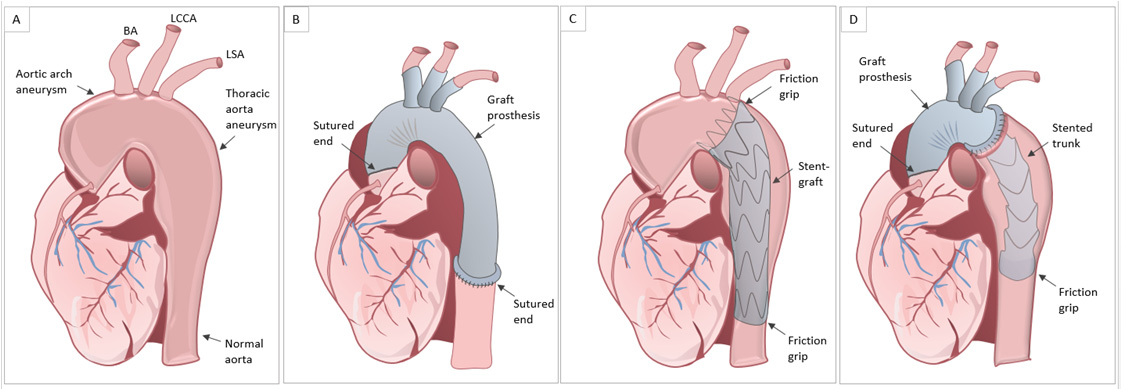
 DownLoad:
DownLoad: 